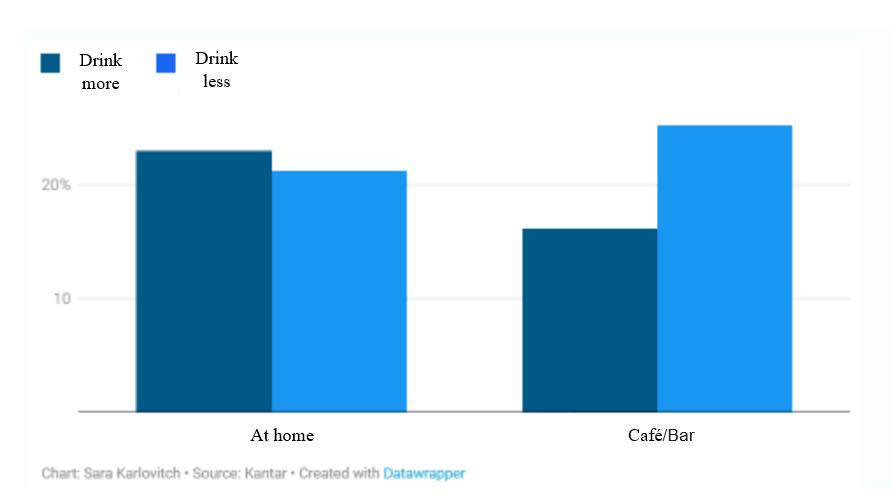16.07.2024
News
Study
Alcohol buying trends are changing – here’s what the numbers say
With consumers increasingly favoring home-brewed alcohol, many are leaning toward experimentation and more sophisticated soft drinks.
Despite the reopening of bars and restaurants after the COVID-19 pandemic, home consumption of alcohol is on the rise, while consumption in establishments continues to fall. According to a new report by Kantar, trends suggest that the alcohol market is still undergoing changes, both related and unrelated to the pandemic, with other factors such as inflation proving influential.
The Alcoholic Beverage Purchases report found that 23% of consumers drank more at home in the past 12 months, compared to 16% who drank more in public places. However, consumers are generally reducing their alcohol consumption: 21% reported drinking less at home over the same period, compared to 25% of those who drink in bars and restaurants.

“Even after the pandemic, consumers are consuming more alcoholic beverages at home than in bars and are cutting back on their consumption. And that’s mainly because they are affected by inflation,” says Renata de Moura, author of the study and senior director of shopper and category research at Kantar. “They are trying to reduce their consumption of premium beverages outside the home and are buying more and consuming more at home.”
The study surveyed 2,000 consumers aged 21 and over who had purchased alcohol in the past three months. 52% of respondents are women, 48% are men. The largest age demographic group of respondents is millennials (38%), and the smallest is Generation Z (8%).
Less is more
Consumers, especially Generation Z and millennials, are not only drinking less on the street, but are also gravitating toward non-alcoholic beverages. For example, 21% of Generation Z and 18% of Millennials have purchased a non-alcoholic beer in the past 12 months. When visiting bars, 21% of consumers reported that the availability of non-alcoholic beverages plays an important role in their overall experience. One reason for this trend may be the growing desire for healthier products.
“People are looking for healthy drinks, especially younger shoppers. They are looking for alternatives that do not contain ingredients that are harmful to them, are low in carbohydrates or sugar,” says de Moura.
However, attitudes toward non-alcoholic options seem to be unstable. For example, 45% of consumers are not interested in switching to non-alcoholic beverages, although 12% said they have already done so. However, 29% of consumers are interested in alcohol-free products and would likely buy them, while 15% said that while they are interested, they are unlikely to buy them. While marketers may find this picture confusing, the alcohol-free trend is likely to have some sustainability and potential.
“It’s nice to have a gourmet option that doesn’t depend on calories or price for temptation,” says Lee O’Donnell, head of shopper and category research at Kantar. “The things that are really driving trends in the alcohol industry, like herbal drinks and different flavor configurations, are very sophisticated and layered, and soft drinks I think are really driving the sophistication that has become extremely popular in the home as well as in bars and restaurants.”
Time and place
The types of alcoholic beverages consumers buy and their motivations are also changing. In particular, ready-to-drink (RTD) and strong seltzer are becoming a substitute for more traditional alcoholic beverages. For example, 33% of consumers buy hard seltzer as opposed to other alcoholic beverages, while 37% buy RTD cocktails. This data may indicate an overall increase in home consumption of alcohol, with RTD cocktails being seen as a convenient and cost-effective alternative.
Other alternatives to beer are also attracting growing interest: 58% of consumers are already buying or are interested in buying drinks with added sparkling water. Even more unusual alcoholic products such as strong coffee are also attracting interest: 49% of consumers buy or are interested in buying strong coffee. According to de Moura, the interest in experimentation can be partly explained by the growing influence of smartphones.
“One of the important factors contributing to this is social media. Customers go to TikTok for recipes, and this really encourages them to just look for new products and options for combining alcohol in drinks,” de Moura notes.
However, innovation is not the only thing that drives sales. Reasons to buy all types of alcohol, including beer, spirits and wine, are driving the sales. Thirty-three percent of consumers have purchased at least one of these categories for a specific occasion – more than any other category. This can be a challenge for marketers who sell alcoholic beverages on-premise, or for alcohol brands that do a significant portion of their business through bars and restaurants.
As people celebrate at home or drink only on special occasions, this could mean a decrease in regular business. For marketers, experimenting and catering to consumers’ interests can help them weather this storm.
“For bars, one of the areas [to attract customers] is alcoholic beverages, right?” – says de Moura. “Anything that has to do with alcohol, all the innovations – all of that attracts customers to bars.”